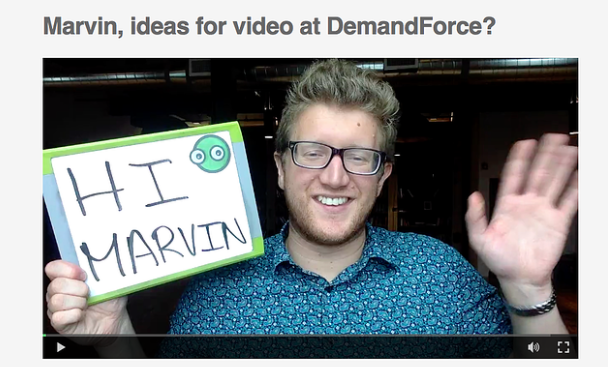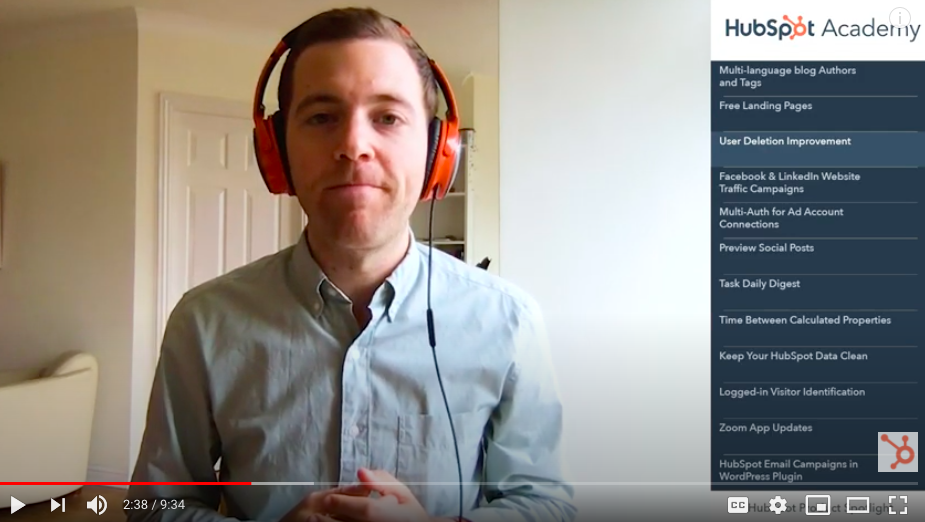We all know video is an essential part of marketing and building customer engagement, but for many companies we talk to, they see their video efforts as disconnected from their overall marketing strategy. They are looking for ways to not only get more from their video investment, but also produce video quickly and efficiently.
That’s the problem HubSpot and Vidyard were trying to solve when they partnered to create HubSpot Video. The integrated tool includes a series of video features woven throughout the marketing, sales, and service hubs. It’s menu of native video features within the platform, from hosting to analytics, is intended to optimize your video strategy.
In this post, we look at the tool and some ways your company can use it in your sales process to improve prospecting and customize lead nurturing.
What does HubSpot Video do?
Thanks to the Vidyard and HubSpot partnership, you can use HubSpot Video seamlessly across different hubs, as if video were any other piece of content. To use it effectively, however, you have to know how the functionality varies across the hubs.
- Marketing Hub: This is where you host video files inside the HubSpot platform, optimize them for SEO, add interactive CTAs, and embed videos into your HubSpot website pages, blog posts, and social media posts.
- Sales Hub: Where sales teams can create and send personalized video messages to contacts.
- Service Hub: Saves service reps time with easy-to-follow videos for responding to support tickets. You can also embed videos directly into your knowledge base articles to help customers find answers quickly.
To turn HubSpot Video on, all users have to do is enable it when prompted by accepting Vidyard’s terms of service, if you haven’t already. It’s that easy!
Before accessing the capabilities within HubSpot Video, you must upload your video content directly into HubSpot. Fortunately, users can host up to 250 videos for free in the file manager. These can then be embedded into blog posts, landing pages, sales emails, and include calls-to-action and forms for lead capture.
New features unveiled at INBOUND 2020
At INBOUND 2020, HubSpot and Vidyard announced the addition of new analytics and reporting features to HubSpot Video. These features give users insight into exactly which videos their contacts are watching, when they’re watching them, and how much of the video is consumed during their session. This information, combined with the tools within HubSpot, can be leveraged to improve user experience, deliver smart content, and refine messaging to various leads.
HubSpot also made changes to the drag-and-drop content management system, making it easier to embed and customize videos on website pages, landing pages, and email marketing campaigns. Additional customization features have also been added, such as customized video thumbnails, and branding features on video players.
There are still a number of advanced features only available to companies that opt for a Vidyard subscription upgrade, such as embedding videos hosted by HubSpot outside of their platform, as well as enabling captions.
Bottom line? The new analytics and tools give users more insight into how their online video content is performing and help create a more customized experience.
How to use HubSpot Video for sales
In sales, it helps to stand out, whether it’s great imagery or an unforgettable message. HubSpot Video for sales was designed to make sales emails stand out to prospects and leads, by delivering customized messages that directly answer their questions.
According to Vidyard, sales emails that include a video message have an open-to-reply rate that’s eight times higher than emails without video. Salesloft reported that sales prospects who viewed a video during the sales process were 85% more likely to close, and 75% of late-stage prospects who received a personalized video closed.
When you consider that the average prospect receives more than 100 emails a day, using video for sales emails is a great way to cut through the clutter.
Some members of your sales team may balk at the idea of recording personalized messages—not everyone loves the camera—but with these numbers, it’s hard to pass up the potential boost in sales.
At a glance, here are some ways your team can use HubSpot Video for sales:
- Create in-video CTAs with links to your website pages, like a blog post, meetings page, or pricing page.
- Customize your video sharing page so it aligns with your brand and is distraction-free.
- Share videos and playlists across your team with shared folders.
- Provide product demos, customer testimonials, and marketing videos to leads.
- Download multiple versions of a video from your library to use elsewhere.
- See which videos your contacts are watching and how long they watch for.
- Build lists and automate nurture workflows based on video engagement data.
For more tips on how to use HubSpot Video for sales, check out this free lesson on HubSpot Academy.
When it comes to everyday use of HubSpot Video, think of it as an extension of an inbound marketing approach to sales. Video isn’t for showing off, but for solving your prospect’s problems. Here are two scenarios where we think just about any business can use the tool.
HubSpot Video for sales example #1

Say your lead has questions about how your service or product will work for their specific business. You can quickly record a tutorial explaining the details using the screen and voice recording feature. Send the video immediately via email without having to upload or transfer between platforms.
When the viewer clicks the video image, they will jump to an automatically created landing page where they can watch. To ensure your sales process stays on track, the video email gets logged in the CRM, showing you when prospects open and click.
HubSpot Video for sales example #2

You’re reaching out to a new lead for the first time and you want to make a good impression. Using an office conference room (or your home office) record a short message on your laptop to introduce yourself, your product or services, and how it will help them. Start your message by also holding up a whiteboard with the lead’s name, or a question to grab their attention the second they press play. Finish with a succinct call-to-action showing them how to learn more.
Next, customize the video thumbnail in HubSpot to show you holding the whiteboard with their name—this will help grab their attention when they open the email. Add the video to your sales email with a quick message inviting them to watch, then send. Don’t forget to add VIDEO to the email subject line. From there you can check back in HubSpot to see if they opened the email and how much they watched.
Video for sales best practices
No matter the company or the type of leads you’re nurturing, these guidelines will ensure you get the message across efficiently and your team looks professional.
- Write a script: This isn’t the kind of script you’re going to memorize word-for-word, or read off a prompter like a robot. Sometimes referred to as a scriptosis, it’s a series of bullet points you want to quickly hit, keeping your video on track, and preventing multiple takes because you forgot something to say.
- Keep it short. While you’re writing your script, keep it to just a few sentences, or under 30 seconds, for an introduction or “quick tip” video. It should be under 350 words, or less than three minutes, for product-related ones.
- Pick the right setting. Set up your laptop or camera, adjust so your eyes are in the top third of the screen, but your head is not chopped off, and then pause—is there anything in the background that could be distracting or unprofessional? Can you hear loud talking or a fan? You want the lead to remember you, not the whirring of an espresso machine in the background.
- Use props. This may seem like a gimmick, but you want your message to be personal, entertaining, and memorable. As mentioned in the example above, write your contact’s name on a whiteboard to show it’s a video just for them.
Buyers are busy. They have enough emails to read. They just want you to cut through the clutter and get to the heart of your sales message. By using video, you’re meeting leads where they are. If you’re already using HubSpot Sales Hub, integrating video into your sales strategy can be done quickly and within a platform your team already knows. Plus, the tool cuts to the heart of what marketing and sales teams need—a quick and easy way to get memorable messages to prospects and leads.





